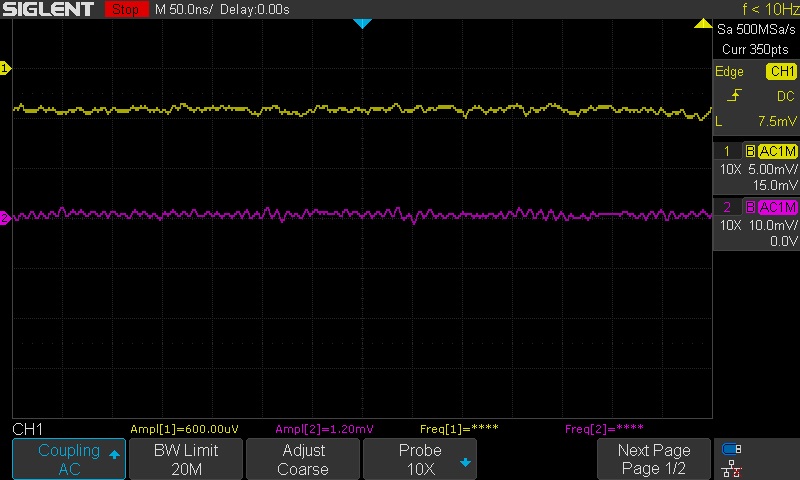Inductance Test
Feb 9th/2020
Purpose
To add inductance in series with the positive leg of the load and observe the circuit’s reaction.
Setup
Probe #1 – Yellow – Attached to MOSFET input pin. A 15.0mV offset may have been left on, throughout testing.
Probe #2 – Purple – Attached to shunt resistor input pin.
38.38uH of inductance was added in series with the load on the positive leg.
Beginning ambient temperature 22-23*C.
The current setting of the circuit was determined with a separate DMM.
The face temperature of the MOSFET was determined with a separate DMM.
Ambient Noise
This picture was taken after the end of the first test level. The test system was left fully in place and the only change made was that the PSU supply was switched to standby.

First Level of Testing
PSU set to 10.0v and 1.4a. The addition of 0.40a was added to test for circuit advancement beyond the circuit’s current setting of 1.0a.
Circuit set to 1.0a
Soak time = 30 minutes
MOSFET face temperature revolved around 35*C, with minor variations.

Second Level of Testing
PSU set to 30.0v and 2.4a. The addition of 0.40a was added to test for circuit advancement beyond the circuit’s current setting of 2.0a.
Circuit set to 2.0a
Soak time = 30 additional minutes
MOSFET face temperature revolved around 108*C, with minor variations.

Observations
Both positive and negative amplitude variations were observed at both test levels. They manifested as signal jumps, being whole lines, or slopes. It is important to note that these events were not spikes. The current sunk remainded steady and had only minor float.
I am not experienced enough with my scope to collect the max/min data through the scope’s functions. But, I did try to use the max/min settings and I was able to see 400mV readings, most often, during the instantaneous fluctuations. This same 400mV reading was observed with the supply set to standby, but it occurred as spikes. I am not saying that the maximum reading was 400mV, only that it occurred enough for me to see it among the flashes.
Conclusion
The jumps in amplitude will be investigated. I think my new scope can record a session. If so, I will repeat the test and make a movie.
My guess is that the jumps in amplitude may be a build up and collapse of the inductance? This is beyond my present knowledge, but I am sure Kleinstein can set us straight.
I would think that the majority of the noise observed is from ambient sources.
The results are encouraging. With the circuit at its full design limits, 30v/2a/60w and with inductance added, the circuit yielded these results…
- Steady current sinking operations.
- Low noise.
- Low MOSFET face temperature
We are, again, in need of Kleinstein’s wisdom and knowledge… To draw conclusions from the above… And, to determine what needs to be done next.
One additional thought… I have recently learned about current mirrors and I wonder if one might be useful to balance the load between the two MOSFETs, in the Dual MOSFET model.